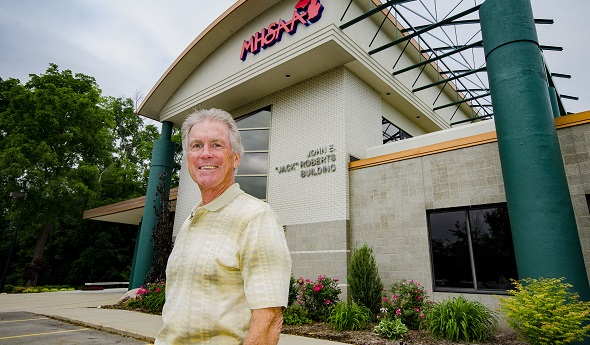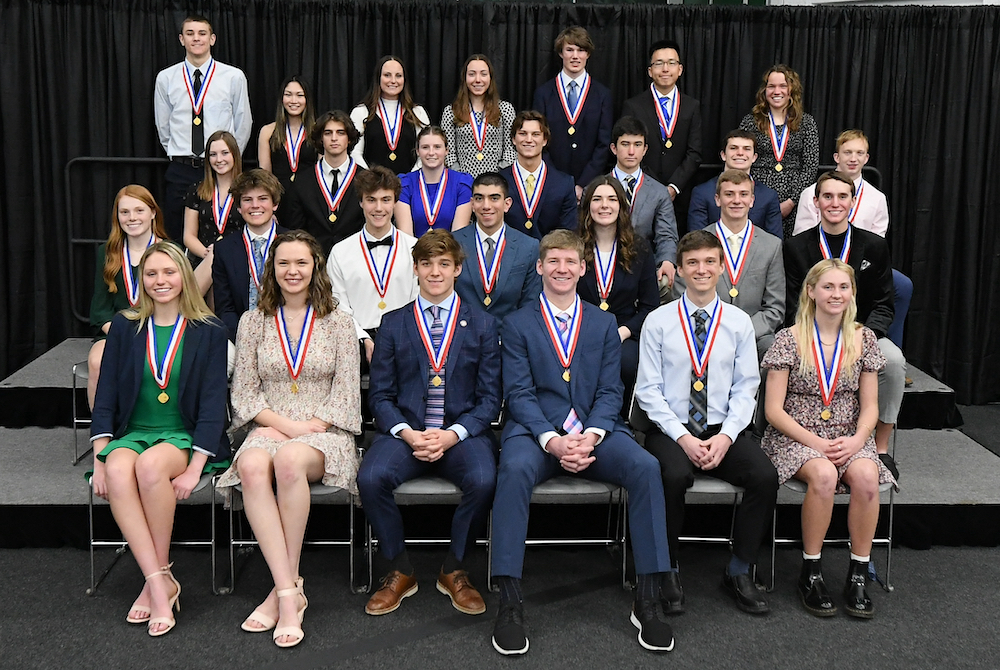
MHSAA Building Named for Retiring Director
By
Geoff Kimmerly
MHSAA.com senior editor
June 26, 2018
To recognize 32 years of leadership and service to Michigan educational athletics, the MHSAA Representative Council has named its home office in East Lansing after longtime Executive Director John E. “Jack” Roberts, who will retire in August.
The dedication of the “John E. ‘Jack’ Roberts Building” was approved by the Council during its Spring Meeting, May 6-7 in Gaylord, with the fabrication and assembly of the lettering financed by several private donations.
The building, located at 1661 Ramblewood Drive in East Lansing, opened as headquarters for the Association on January 3, 1997. The 20,000-square-foot, two-story facility houses MHSAA staff offices and resources including a publications library, plus multiple conference spaces frequently used to host meetings not only for MHSAA business but by leagues, coaches associations and other groups joining people from across the state.
Roberts, who announced his retirement April 24, will conclude his tenure next month as the second-longest serving full-time executive director during the MHSAA’s 94-year history. He is the fourth person to serve that leadership role full time, following Charles E. Forsythe (1931-42, 1945-68), Allen W. Bush (1968-78) and Vern L. Norris (1978-86). Roberts currently is also the nation’s longest-serving executive director of a state high school athletic association.
“This is an entirely unexpected honor,” Roberts said, “and while I am proud of the building, I’m even prouder of the people who have worked in it.”
The metallic lettering announcing the building’s name was designed by Image360 of Brighton and placed on the façade at the center of the building below the large MHSAA logo facing the property’s parking lot.
John Peckham, then of Martin Property Development of East Lansing, oversaw the original Ramblewood project. The building was designed by Keystone Design and built by Granger Construction.
Prior to the move to its current offices, the MHSAA was housed at 1019 Trowbridge Road in East Lansing from 1976-96. The MHSAA moved to the Trowbridge location from a downtown Lansing office it had leased since 1958.
With his retirement upcoming, Roberts also will leave the National Federation of State High School Associations (NFHS) Board of Directors later this week during the Summer Meeting in Chicago. He also will conclude an extended term as board chairperson of the NFHS Network. Roberts previously served as an assistant director for the National Federation from 1973-80 and came to the MHSAA in the fall of 1986 from the Fellowship of Christian Athletes, which he served as executive vice president.
Assistant Director Mark Uyl was chosen by the Representative Council in May to succeed Roberts as MHSAA executive director.
The MHSAA is a private, not-for-profit corporation of voluntary membership by more than 1,500 public and private senior high schools and junior high/middle schools which exists to develop common rules for athletic eligibility and competition. No government funds or tax dollars support the MHSAA, which was the first such association nationally to not accept membership dues or tournament entry fees from schools. Member schools which enforce these rules are permitted to participate in MHSAA tournaments, which attract more than 1.4 million spectators each year.

Finalists Announced for 2022-23 MHSAA-Farm Bureau Insurance Scholar-Athlete Awards
By
Geoff Kimmerly
MHSAA.com senior editor
January 18, 2023
The 120 finalists for the Michigan High School Athletic Association's Scholar-Athlete Awards for the 2022-23 school year, presented by Farm Bureau Insurance, have been announced.
The program, in its 34th year, has recognized student-athletes since the 1989-90 school year and again this winter will honor 32 individuals from MHSAA member schools who participate in at least one sport in which the Association sponsors a postseason tournament.
Farm Bureau Insurance underwrites the Scholar-Athlete Awards and will present a $2,000 scholarship to each recipient. Since the beginning of the program, 896 scholarships have been awarded.
Scholarships will be presented proportionately by school classification, with 12 scholarships to be awarded to Class A student-athletes, six female and six male; eight scholarships will be awarded to Class B student-athletes, four female and four male; six scholarships will be awarded to Class C student-athletes, three female and three male; and four scholarships will be awarded to Class D student-athletes, two female and two male. In addition, two scholarships will be awarded at-large to minority recipients, regardless of school size.
Every MHSAA member high school could submit as many applications as there are scholarships available in its classification and could have more than one finalist. Bloomfield Hills Cranbrook Kingswood has four finalists and Kalamazoo Loy Norrix and Midland Dow have three finalists this year. Twelve schools have two finalists: Ada Forest Hills Eastern, Cass City, Fenton, Hillsdale Academy, Holland, Holland Christian, Milford, Negaunee, Northville, Saginaw Michigan Lutheran Seminary, South Lyon East, and Tecumseh.
Multiple-sport participation remains the norm among applicants. The average sport participation rate of the finalists is 2.88. There are 74 three-plus sport participants in the finalists field, and all but two of the 28 sports in which the MHSAA sponsors postseason tournaments are represented.
Of 421 schools which submitted applicants, 25 submitted the maximum allowed. This year, 1,440 applications were received. All applicants will be presented with certificates commemorating their achievement. Additional Scholar-Athlete information, including a complete list of scholarship nominees, can be found on the Scholar-Athlete page.
The applications were judged by a 65-member committee of school coaches, counselors, faculty members, administrators and board members from MHSAA member schools. Selection of the 32 scholarship recipients will take place in early February. Class C and D scholarship recipients will be announced Feb. 7, Class B scholarship recipients will be announced Feb. 14 and Class A scholarship recipients will be announced Feb. 21. All announcements will be made on the MHSAA Website.
To be eligible for the award, students must have a cumulative grade-point average of 3.50 (on a 4.0 scale) and previously have won a varsity letter in at least one sport in which the MHSAA sponsors a postseason tournament. Students also were asked to respond to a series of short essay questions, submit two letters of recommendation and a 500-word essay on the importance of sportsmanship in educational athletics.
Farm Bureau Insurance of Michigan was founded in 1949 by Michigan farmers who wanted an insurance company that worked as hard as they did. Those values still guide the company today and are a big reason why it is known as Michigan’s Insurance Company, dedicated to protecting the farms, families, and businesses of this great state. Farm Bureau Insurance agents across Michigan provide a full range of insurance services—life, home, auto, farm, business, retirement, Lake Estate®, and more—protecting nearly 500,000 Michigan policyholders.
The MHSAA is a private, not-for-profit corporation of voluntary membership by more than 1,500 public and private senior high schools and junior high/middle schools which exists to develop common rules for athletic eligibility and competition. No government funds or tax dollars support the MHSAA, which was the first such association nationally to not accept membership dues or tournament entry fees from schools. Member schools which enforce these rules are permitted to participate in MHSAA tournaments, which attract more than 1.3 million spectators each year.
2022-23 Scholar-Athlete Award Finalists
GIRLS CLASS A
Daria Igonin, Belleville
Ella Blank, Birmingham Groves
Ella Thomas, Brownstown Woodhaven
Keira Tolmie, Clarkston
Nora Chamas, Dearborn
Miryam El-Saghir, Dearborn Edsel Ford
Abigail Frushour, DeWitt
Rachel Williamson, East Grand Rapids
Naomi Sowa, East Lansing
Adrienne Staib, Fenton
Abigail Cumings, Grand Rapids Forest Hills Central
Ella Eitniear, Grand Rapids Kenowa Hills
Sophia Borowski, Grosse Pointe North
Eva Whiteman, Holland
Ana Dunfee, Kalamazoo Loy Norrix
Wendy Miedema, Kalamazoo Loy Norrix
Colleen Blackwood, Linden
Kathleen Doneth, Mason
Caroline Colt, Milford
Leah Merriam, Milford
Sophia Hekkema, Muskegon Reeths-Puffer
Jane Barnett, Royal Oak
Kate Mazur, South Lyon East
Amyla Eberhart, South Lyon East
BOYS CLASS A
Henry Jackson, Bloomfield Hills
Connor Anderson, Cadillac
Isaac David Clark, Caledonia
Braylen Himmelein, Davison
Nathan Katic, Fenton
Isaac Postema, Grand Haven
Ryan Lee, Grand Rapids Forest Hills Northern
Brayden Ryan LaCroix, Grandville
Brendan Downey, Grosse Pointe South
James R. Baer, Holland
Treyton William Carr, Hudsonville
James Rocco, Kalamazoo Loy Norrix
James Patterson Jr., Lake Orion
Shubhan Nagarkar, Midland Dow
Danny Safadi, Midland Dow
Jack Bakus, Midland Dow
Gavyn Stout, Muskegon Mona Shores
Abhinav Attaluri, Northville
David Whitaker, Northville
Samuel Gibson, Plainwell
Harsimmer Sohi, Portage Central
Shane Pitcher, Saline
Ian Robertson, Traverse City West
Trevor Wallar, Zeeland West
GIRLS CLASS B
Devin Johnston, Almont
Rylie Haist, Big Rapids
Jordan Richie, Bloomfield Hills Cranbrook Kingswood
Anna Smith, Clawson
Carney Salo, Escanaba
Ella Wagner, Essexville Garber
Lauren Harrold, Flint Powers Catholic
Tiffany Keller, Frankenmuth
Ainsley VandenBrink, Holland Christian
Claire Filpus, Houghton
Elaina Bortolini, Kingsford
Matelyn Midkiff, Midland Bullock Creek
Rachel Niskanen, Negaunee
Molly McNitt, Paw Paw
Chesney Wilke, Tecumseh
Allison Tate, Whitehall
BOYS CLASS B
Sreejay Ramakrishnan, Ada Forest Hills Eastern
Jacob Pallo, Ada Forest Hills Eastern
Aiden Eric Smith, Adrian
Evan Jose Evans, Bloomfield Hills Cranbrook Kingswood
John Kersh, Bloomfield Hills Cranbrook Kingswood
Nathan Hooker, Bloomfield Hills Cranbrook Kingswood
Jacob Fenbert, Dundee
Michael App, Grand Rapids Catholic Central
James Oosterhouse, Holland Christian
Matthew Bowman, Milan
Philip Nelson, Negaunee
Grant H. Harkness, Newaygo
Nicholas Liparoto, Pontiac Notre Dame Prep
Isaiah Pelc, Portland
Aldo Barba, Tecumseh
Camden Johnecheck, Williamston
GIRLS CLASS C
Tailor Onstott, Beal City
Saylar Cuthrell, Cass City
Kylie McGrath, Cass City
Claire Scholten, Charlevoix
Ruby Sierer, Clinton
Quinn Watts, Fowler
Danni Swihart, Hanover-Horton
Aziza Burgoon, Iron Mountain
Abigail Meyer, Marlette
Alaina Andrews, Ottawa Lake Whiteford
Laina Harger, St. Charles
Samantha Dietz, Watervliet
BOYS CLASS C
Logan Pflug, Cassopolis
Seth Vanderwest, Kent City
Ethan Green, Kingston
Andrew Mleczko, Madison Heights Bishop Foley
Grant Mason, Manistique
Blake O'Connor, Maple City Glen Lake
Brock Murphy, Menominee
Riley DeSarbo, Monroe St. Mary Catholic Central
Ty Kohlmann, New Lothrop
Noah Etnyre, Plymouth Christian Academy
Brennan Cannaday, Royal Oak Shrine Catholic
Dirk Rierson, Unionville-Sebewaing
GIRLS CLASS D
Kylie Quist, Athens
Kasandra Lynn Waldi, Chesterfield Austin Catholic
Megan Roberts, Hillsdale Academy
Emma Case, Kinde North Huron
Monique Brisson, Munising
Makennah Uotila, Ontonagon
Gabriella Wenzel, Saginaw Michigan Lutheran Seminary
Macey Springer, Three Oaks River Valley
BOYS CLASS D
Ryan McDonell, Bay City All Saints
Luke Walker, Clarkston Everest Collegiate
Amos Norland, Dollar Bay
Brody Appelgren, Hillman
Caleb Diener, Hillsdale Academy
Matthew Zammit, Marine City Cardinal Mooney
James Blackburn, Martin
Caleb Munson, Saginaw Michigan Lutheran Seminary
PHOTO A group including 27 of last season's 32 MHSAA-Farm Bureau Insurance Scholar-Athlete Award winners take a photo together during the banquet at Breslin Center.

